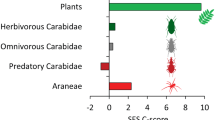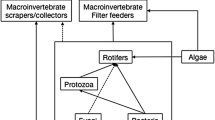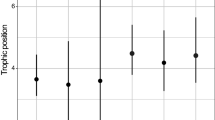Summary
Menge and Sutherland (1976) predicted that in physically benign habitats: (1) community structure will be most strongly affected be predation, (2) the effect of predation will increase with a decrease in trophic position in the food web, (3) trophically intermediate species will be influenced by both predation and competition, and (4) competition will occur among prey species which successfully escape consumers. These predictions were tested in a tropical rocky intertidal community on the Pacific coast of Panama. The most abundant mobile species included fishes and crabs, which occupied the top trophic level, and predaceous gastropods and herbivorous molluscs, which occupied intermediate trophic levels. The most abundant sessile organisms were encrusting algae, foliose algae, barnacles, and bivalves. Diets were broad and overlapping, and 30.3% of the consumers were omnivorous. Each consumer group had strong effects on prey occurring at lower trophic levels: (1) Fishes and crabs reduced the abundance of predaceous snails, herbivorous molluscs, foliose algae, and sessile invertebrates. (2) Predaceous gastropods reduced the abundance of herbivorous molluscs and sessile invertebrates. (3) Herbivorous molluscs reduced the abundance of foliose algae and young stages of sessile invertebrates, and altered relative abundances of the encrusting algae. The encrusting algae, although normally the dominant space occupiers, proved to be inferior competitors for space with other sessile organisms when consumers were experimentally excluded. However, the crusts escaped consumers by virtue of superior anti-herbivore defenses and competed for space despite intense grazing. Observations do not support the hypothesis that the trophically intermediate species compete. Hence, with the exception of this last observation, the predictions of the Menge and Sutherland model were supported. Although further work is needed to evaluate other predictions of the model in this community, evidence from this study joins an increasing body of knowledge supporting the model. Contradictory evidence also exists, however, indicating that aspects of the model require revision.
Similar content being viewed by others
References
Bertness MD, Garrity SD, Levings SC (1981) Predation pressure and gastropod foraging: a tropical-temperate comparison. Evolution 35:995–1007
Brown JH, Davidson DW, Munger JC, Inouye RS (1986) Experimental community ecology: the desert granivore system. In: Diamodn J, Case TJ (eds) Community ecology. Harper and Row Inc, New York, NY pp 41–61
Connell JH (1975) Some mechanisms producing structure in natural communities: a model and evidence from field experiments. In: Cody ML, Diamond JM (eds) Ecology and evolution of communities. Belknap Press of Harvard University Press, Cambridge MA, pp 460–490
Connell JH (1980) Diversity and the coevolution of competitors, or the ghost of competition past. Oikos 35:131–138
Connell JH (1983) On the prevalence and relative importance of interspecific competition: evidence from field experiments. Am Nat 122:661–696
Cubit J (1984) Herbivory and the seasonal abundance of algae on a high intertidal rocky shore. Ecology 65:1904–1917
Fairweather PG, Underwood AJ (1983) The apparent diet of predators and biases due to different handling times of their prey. Oecologia (Berlin) 56:169–179
Fairweather PG, Underwood AJ, Moran MJ, (1984) Preliminary investigations of predation by the whelk Morula marginalba. Mar Ecol Prog Ser 17:143–156
Gaines SD (1983) Diverse consumer guilds in intertidal communities of Oregon and the Republic of Panama and their effects on prey assemblages. PhD Diss, Oregon State Univ, Corvallis, Oregon
Gaines SD (1984) Herbivory and between habitat diversity: the differential effectiveness of a marine plant defense. Ecology 66:473–485
Garrity SD (1984) Some adaptations of gastropods to physical stress on a tropical rocky shore. Ecology 65:559–574
Garrity SD, Levings SC (1981) A predator-prey interaction between two physically and biologically constrained tropical rocky shore gastropods: direct, indirect, and community effects. Ecol Monogr 51:267–286
Garrity SD, Levings SC (1983) Homing to scars as a defense against predators in the pulmonate limpet Siphonaria gigas. Mar Biol 72:319–324
Glynn PW (1972) Observations on the ecology of the Caribbean and Pacific coast of Panama. Bull Biol Soc Wash 2:13–30
Glynn PW, Stewart RH (1973) Distribution of coral reefs in the Pearl Islands (Gulf of Panama) in relation to thermal conditions. Limnol Oceanogr 18:367–379
Hairston NG, Smith FE, Slobodkin LB (1960) Community structure, population control, and competition. Am Nat 94:421–425
Hiatt RW, Strasburg DW (1960) Ecological relationships of the fish fauna on coral reefs of the Marshall Islands. Ecol Monogr 30:65–127
Hobson ES (1974) Feeding relationships of teleostean fishes on coral reefs in Kona, Hawaii. Fish Bull 72:915–1031
Levings SC, Garrity SD (1983) Diel and tidal movement of two co-occurring neritid snails: differences in grazing patterns on a tropical rocky shore. J Exp Mar Biol Ecol 67:261–278
Levins R (1978) Evolution in changing environments: some theoretical explorations. Monogr Pop Biol 2, Princeton Univ Press, NJ
Lubchenco J (1986) Relative importance of competition and predation: early colonization by seaweeds in New England. In: Diamond J, Case TJ (eds) Community ecology. Harper and Row Inc, New York NY, pp 537–555
Lubchenco J, Menge BA, Garrity SD, Lubchenco PJ, Ashkenas LR, Gaines SD, Emlet R, Lucas J, Strauss S (1984) Structure, persistence and role of consumers in a tropical rocky intertidal community (Taboguilla Island, Bay of Panama). J Exp Mar Biol Ecol 77:23–73
Lynch M (1979) Predation, competition, and zooplankton community structure: an experimental study. Limnol Oceanogr 24:253–272
MacArthur RH (1972) Geographical ecology Harper and Row, New York, NY
Mauzey KP, Birkeland C, Dayton PK (1968) Feeding behavior of asteroids and escape responses of their prey in the Puget Sound region. Ecology 49:603–619
McNaughton SJ (1983) Serengeti grassland ecology: the role of composite environmental factors and contingency in community organization. Ecol Monogr 53:291–320
Menge BA (1972) Foraging strategy of a starfish in relation to actual prey availability and environmental predictability. Ecol Monogr 42:25–50
Menge BA (1978a) Predation intensity in a rocky intertidal community: relation between predator foraging and environmental harshness. Oecologia (Berlin) 34:1–16
Menge BA (1978b) Predation intensity in a rocky intertidal community: effect of an algal canopy, wave action and desiccation on predator feeding rates. Oecologia (Berlin) 34:17–35
Menge BA, Farrell TM (1986) Patterns of community structure and organization in rocky intertidal habitats: evaluation of a general model. In: Turner RE, wolff V (eds) Coastal ecology sourcebook. John Wiley and Sons, New York, NY (in press)
Menge BA, Lubchenco J (1981) Community organization in temperate and tropical rocky intertidal habitats: prey refuges in relation to consumer pressure gradients. Ecol Monogr 51:429–450
Menge BA, Sutherland JP (1976) Species diversity gradients: synthesis of the roles of predation, competition, and temporal heterogeneity. Am Nat 110:351–369
Menge BA, Ashkenas LR, Matson A (1983) Use of artificial holes in studying community development in cryptic marine habitats in a tropical rocky intertidal region. Mar Biol 77:129–142
Menge BA, Lubchenco J, Ashkenas LR (1985) Diversity, heterogeneity and consumer pressure in a tropical rocky intertidal community. Oecologia (Berlin) 65:394–405
Menge BA, Lubchenco J, Ashkenas LR, Ramsey F (1986) Experimental separation of effects of consumers on sessile prey on a rocky shore in the Bay of Panama: direct and indirect consequences of food web complexity. J Exp Mar Biol Ecol 100:225–269
Menge JL, Menge BA (1974) Role of resource allocation, aggression and spatial heterogeneity in coexistence of two competing intertidal starfish. Ecol Monogr 44:189–209
Morin PJ (1983) Predation, competition, and the composition of larval anuran guids. Ecol Monogr 53:119–138
Ortega S (1985) Competitive interactions among tropical intertidal limpets. J Exp Mar Biol Ecol. 90:11–25
Paine RT (1980) Food webs: linkage, interaction strength and community infrastructure. J Anim Ecol 49:667–685
Paine RT, Castillo JC, Cancino J (1985) Perturbation and recovery patterns of starfish-dominated intertidal assemblages in Chile, New Zealand, and Washington State. Am Nat 125:679–691
Palmer AR (1979) Fish predation and the evolution of gastropod shell sculpture: experimental and geographic evidence. Evolution 33:697–713
Peckarsky BL (1983) Biotic interactions or abiotic limitations? A model of lotic community structure. In: Fontaine III TD, Bartell SM (eds) Dynamics of lotic ecosystems. Ann Arbor Science Publishers, Ann Arbor, MI
Peckarsky BL, Dodson SI (1980) An experimental analysis of biological factors contributing to stream community structure. Ecology 61:1283–1290
Peterson CH, Bradley BP (1978) Estimating the diet of a sluggish predator from field observations. J Fish Res Board Can 35:136–140
Pimm SL (1980) Properties of food webs. Ecology 61:219–225
Quinn JF, Dunham AE (1983) On hypothesis testing in ecology and evolution. Am Nat 122:602–617
Randall JE (1967) Food habits of reef fishes of the West Indies. Stud Trop Oceanogr (Miami) 5:665–847
Roughgarden J (1983) Competition and theory in community ecology. Am Nat 122:583–601
Russ GR (1980) Effects of predation by fishes, competition, and structural complexity of the substratum on the establishement of a marine epifaunal community. J Exp Mar Biol Ecol 42:55–69
Schoener TW (1983) Field experiments on interspecific competition. Am Nat 122:240–285
Schoener TW (1985) Some comments on Connell's and my reviews of field experiments on interspecific competition. Am Nat 125:730–740
Sih A, Crowley P, McPeek M, Petranka J, Strohmeier (1985) Predation, competition, and prey communities: a review of field experiments. Ann Rev Ecol Syst 16:269–311
Strong DR Jr (1983) Natural variability and the manifold mechanisms of ecological communities. Am Nat 122:636–660
Underwood AJ (1978) An experimental evaluation of competition between three species of intertidal prosobranch gastropods. Oecologia (Berlin) 33:185–202
Underwood AJ, Denley EJ, (1984) Paradigms, explanations and generalizations in models for the structure of intertidal communities on rocky shores. In: Simberloff D, Strong DR, Abele L, Thistle AR (eds) Ecological communities: conceptual issues and the evidence. Princeton Univ Press, Princeton NJ, pp 151–180
Underwood AJ, Jernakoff P (1981) Effects of interactions between algae and grazing gastropods on the structure of a low-shore intertidal algal community. Oecologia (Berlin) 48:221–233
Underwood AJ, Denley EJ, Moran MJ (1983) Experimental analyses of the structure and dynamics of mid-shore rocky intertidal communities in New South Wales. Oecologia (Berlin) 56:202–219
Watanabe JM (1984) the influence of recruitment, competition, and benthic predation on spatial distributions of threee species of kelp forest gastropods (Trochidae: Tegula). Ecology 65:920–936
Wellington GM, Kuris AM (1983) Growth and shell variation in the tropical Eastern Pacific intertidal gastropod genus Purpura: ecological and evolutionary implications. Biol Bull 164:518–535
Zaret TM (1980) Predation and freshwater communities. Yale University Press, New Haven, Conn
Zipser E, Vermeij GJ (1978) Crushing behavior of tropical and temperatre crabs. J Exp Mar Biol Ecol 31:155–172
Author information
Authors and Affiliations
Rights and permissions
About this article
Cite this article
Menge, B.A., Lubchenco, J., Gaines, S.D. et al. A test of the Menge-Sutherland model of community organization in a tropical rocky intertidal food web. Oecologia 71, 75–89 (1986). https://doi.org/10.1007/BF00377324
Received:
Issue Date:
DOI: https://doi.org/10.1007/BF00377324




